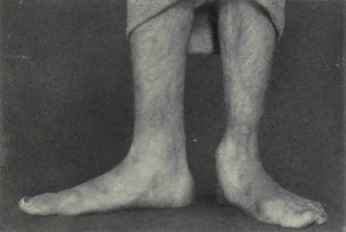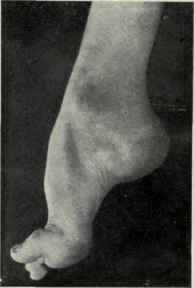Deformities Of The Foot. Part 2
Description
This section is from the book "Applied Anatomy: The Construction Of The Human Body", by Gwilym G. Davis. Also available from Amazon: Applied anatomy: The construction of the human body.
Deformities Of The Foot. Part 2
Talipes Valgus
In talipes valgus the foot is abducted or everted. It is sometimes associated with equinus and sometimes with calcaneus. It is more usually an acquired than a congenital deformity. It is a deformity that has weakness as its primary cause and most marked characteristic. This weakness is either a more or less general one affecting the ligaments and muscles, as shown by its occurring in adolescents, or else primarily a muscular one caused by spinal infantile paralysis (anterior poliomyelitis) (Fig. 596).
From what has been said of the normal movements of the joints (page 569 and ante) it is evident that a weakness of either the muscles or ligaments shows itself first by an eversion of the foot called the pronated foot which is followed by a descent of the tarsal arch or fiat-foot and later by a more complete eversion or pes valgus. They are the three stages of the same process.

Fig. 596. - Paralytic talipes valgus.

Fig. 597. - Flat-foot.
When a young person with apparently normal feet is subjected to excessive strain, as by long standing, etc., the muscles and ligaments are unable to bear the burden. The muscles give way first and the foot everts, mainly at the subastragaloid joint, thus is produced the pronated foot. The patient, unable to support the body weight sufficiently on the weakened muscles, relaxes them and allows the body weight to be borne on the ligaments. This excess of weight on the ligaments supporting the arch causes them to give way and the arch descends and flat-foot results. The process often stops here in the adolescent form or even if rheumatism is the weakening element (Fig. 597).
When paralysis - usually of the extensors and tibialis posterior - is the cause, then the ligaments not being so much affected may maintain the arch intact, but the whole foot is drawn outward by the peroneal and flexor muscles, aided also by the centre of gravity being shifted inward. The deformity is increased by walking and a true valgus results.
In the pronated foot and flat-foot of adolescents pain is often marked so that the relaxation of the inverting muscles is often accompanied by spasm of the everting muscles and the peronei muscles are frequently found markedly contracted. In paralytic valgus the eversion of the foot relaxes the peronei and they gradually shorten. It should be noted that the contraction of the peroneal muscles in one case is active, in the other passive. 37
Treatmerit
In painful pronated and flat feet the contracted muscles can be relaxed by perfect rest in bed. Next the arch can be supported by pads or plates beneath the instep and the weakened muscles strengthened by massage, electricity, or appropriate exercises while the exciting cause of overwork is removed. In paralytic valgus, the foot may be brought straight by forcible stretching and held there by appropriate apparatus; or an artificial ankylosis (arthrodesis) of the subastragaloid and ankle-joints may be made to hold the foot in position; or the peroneal or other tendons, on the outer side of the foot, may be transplanted to the inner.

Fig. 598. - Talipes equinus.
Continue to:


